
www.fanwing.com wrote:The FanWing experimental aircraft opens up a new field of aerodynamics. Engineers have tried for over seventy-five years to find a means of integral lift and thrust using a horizontal-axis wing rotor. Some of these attempts began to get off the ground but none stayed up there. The privately developed FanWing concept is a new departure: the prototype models are capable of controlled and sustained flight and are now already being developed for commercial use as UAV surveillance craft.
How does it work? The aircraft has a cross-flow fan along the leading edge of each wing. The fan pulls the air in at the front and accelerates it over the trailing edge of the wing. By transferring the work of the engine to the rotor, which spans the whole wing, the FanWing accelerates a large volume of air and achieves a high lift-efficiency.
Clear evidence of the proof of concept. Video clips of flights are available on this site and successful wind tunnel tests have been conducted, initially at the University of Rome, with sustained experimentation and tests at Imperial College in 1999 and with the most recently documented tests, sponsored by the UK government, conducted at Imperial College from March to June 2002 and again in September 2002.
An unusually efficient wing. Documented efficiencies for the first prototypes were found to be in the order of 20 grams of lift per watt of input power. With the original basic kitchen-table concept, even before substantial research and development, we were already looking at a lift of 1 –1 ½ tons of weight in the air with 100 hp. And since those early stages there have been demonstrated in the most recent Imperial College wind tunnel experiments a 30% improvement in efficiency, with raised flight speed and improved autorotation.
The flying model prototypes show many actual and predicted strengths:
* Short take-off and landing capability with clearly predictable vertical-take-off possibilities
* Reduced sound emission
* Reduced fuel consumption
* Simple, economical construction with no high-tech requirements for basic manufacture
* High manoeuverability
* Stability in flight - because it’s not sensitive to the angle of the incoming air
* No stall
* Simple control system
The FanWing opens up an enormous potential market. The applications list is extensive, but briefly: the FanWing as a slow, potentially quiet, economical and heavy-load carrying aircraft with short take-off and landing has obvious wide-ranging use from unmanned (UAV) applications in civil and military surveillance to private ultralights and local shuttle, agricultural and urban services and freight haulage.
See also FAQ for detailed discussion of points and issues not covered here.
Mehr dazu zu finden unter: http://www.fanwing.com
Danke an die Yahooler für den Linktipp!

